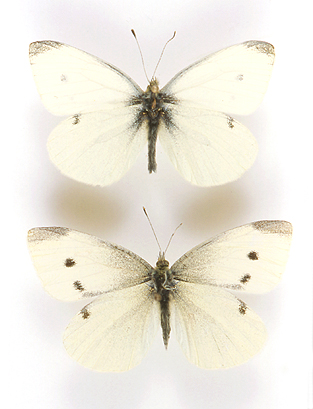Cabbage White Butterfly (Pieris rapae)
Pricing: Dead (spread, as pictured): $10-$20 depending on quality and sex (males are cheapest)
Geographic Range: Holarctic. Introduced to Australia
View: Topsides Sex: TOP IMAGE: Male (top) & Female (bottom) BOTTOM IMAGE: Male
Size: Wingspan: 3.5-5.5 cm


Images Copyright 2003
Barbara Strnadova
Pieris rapae is commonly known as the Cabbage White because its larvae are a common pest of Cabbage (Brassica oleracea). In fact, the caterpillars are fond of many Brassica species as well as a very long list of other plants farmed by humans including: Horseradish (Armoracia rusticana), Bitter Cress (Cardamine oligosperma), Summer Mustard (Hirschfeldia incana), Chinese Radish (Raphanus sativus), Water Cress (Rorippa nasturtium-aquaticum), and dozens of other food plants. The velvety larvae are plain green and seem to need food plants that contain mustard oil; hence it feeds mostly on species in the family Cruciferae (=Brassicaceae). Native to Eurasia, it was introduced to Montreal in the 1860’s and can now be found all over North America, ranging as far south as northwestern Mexico (although it is absent from southern Louisiana, South Texas and the Florida Keys). P. rapae was also introduced into Melbourne, Australia in 1929 and has now infested the entire continent. It is also present in Hawaii. Across many parts of its range, P. rapae is often the most common butterfly, especially in urban areas. In temperate regions, it is often the first butterfly to eclose in spring and the last butterfly to die off in the fall. In the colder parts of it's range, there are 2-3 broods while in warmer climes there can be as many as 7-8! It is easy to see how this butterfly rapidly becomes an abundant garden pest. Pieris rapae is also known as the Small White and by the old Latin synonym Artogeia rapae.